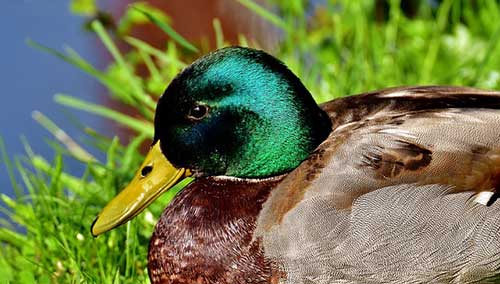I used to visit the zoo a lot in my childhood and there I used to sit beside ducks and watch their activities. Ducks swim and walk on land as well. Mallard ducks are not as simple as the famous Donald duck. My interest in ducks reached a peak and I was shocked because this bird has a lot more interesting life than we see on television.
Do mallard ducks mate for life? No. Mallard ducks don’t mate for life but make seasonal monogamous pairs that separate just as the season comes to an end. Right after the female lays eggs, the male mallard duck leaves the female and eggs. Female duck alone looks after the eggs and raises ducklings.
The common name by which people call male mallard duck is Greenhead and the female mallard duck is called Suzy.
Let’s now explore more but huge facts about mallard ducks!
Table of Contents
Mallard Duck Facts
Normally, you believe that mallard ducks are found everywhere among other ducks, this is what I believe too but there is a misconception that all mallard ducks have a green head. However, only male mallard duck (drake) has a green colored head. Besides, female mallard duck has a brown to tan plumage. Let’s dive deeper into mallard duck’s details:
- Female mallard duck makes the typical quack sound while drakes have a two notes deeper sound.
- You can keep mallard duck as a pet without a lot of effort because they live near any wetland even if that is surrounded by an artificial atmosphere. They are found near rivers, lakes, ponds, marshes, estuaries, coastlines, parks and the backyard. This is the reason mallard ducks can be found almost anywhere in the world.
- Mallard ducks are in a way grand parents of other ducks because the initial ducks that were known were Mallard and Muscovy ducks. They bred with other ducks of different breeds and so other breeds came into being.
- Mallard ducks can be called dabbling ducks. They have been awarded the title because they eat underwater plants and insects by floating on the water. They tip forward as their backs are up in the air.
- Mallard ducks also feed on agricultural grains as they migrate.
- You must be the one to feed mallard ducks bread in the park although you don’t know that bread is not always good for their well being.
- Mallard ducks confidently produce hybrid breeds by mating with the ducks of other species.
- Mallard ducks mate in spring but form their pair in fall while enjoying throughout the winter. You will also notice that the paired and unpaired mallard males will breed with paired females sometimes and this will give birth to multiple father brooding.
- Mallard ducks fly faster than the average waterfowls and the speed can reach up to 55 miles per hour.
- It is possible that a mallard duck lives for 27 years because one such duck was shot by a hunter in 2008 with a tag of some biologists stating 1981. Although not all mallard ducks are seen to be this lucky on average, in the wild they live for 3 to 5 years and 10 years in captivity.
Mallard Duck Mating
So, it is not an easy task for ducks either to find them a mate. In order to find a mate, mallard drake displays courtship by shaking and posturing. He gets to compete with other males as well. The female nods her head to attract the drakes.
She chooses her mate on the basis of his plumage and courtship skills. The male tactically turns his head away from the female hoping she will follow him. The female takes a flight and follows the drake. As she has followed him, she bobs her head making the drake acknowledge that she has accepted his invitation.
It is up to the male to decide the nesting range that he finds convenient to defend. The female chooses the place of the nest and then they mate even several times a day and even as they swim. But beware! During their mating in water, the female duck can sometimes be drowned if the male is being too tough on her.
Mallard Duck Mating Season
The mating season of mallard ducks starts from early March to late May. Although their pair is formed in October and November. They stay together until the end of the breeding season.
Once a mallard female lays eggs, the drake will leave to find himself a new female or to relax.
Female mallard duck all alone raises the young ones and trains them to swim and live on their own.
Mallard Duck Mating Behavior
Mallard ducks usually show the same behavior as the other ducks. As the mating season starts, the males get into a strong competition with other males. Mallard drakes show courtship skills to impress female ducks.
One of the behaviors that mallard drakes show is the grunt whistle. Here the drake pulls himself out of the water and as he goes back to the normal pose, he makes a grunt whistle. This stunt is performed by a group of drakes often. Another stunt which is a seconds-long stunt is when the drake pulls his wings and tail and whistles.
Another short stunt performed by mallard females and males both is that they place their head low along the water surface as if they are grazing. The reason a female duck gives this sign is that she is ready to mate.
One more stunt is when both mallard male and females bob their heads.
Mallard Duck Mating Call
The female mallard duck makes quacking sounds in a series of 2 to 10. In the start this sound is loud but in the end it goes calmer. The male does not quack at all, not just during mating but he always avoids quacking but he takes out a deeper and quieter 2 noted call.
Female mallard ducks quack when they are separated from the partner or when they are alone. Drakes seldom make sounds while ducklings that are famous for their cuteness softly whistle when they are scared.
Mallard Duck Mating Rituals
It is not about mallard drakes only but both male and female mallard ducks become aggressive during the mating season. One of the reasons is that they have to push their competitors away from them or from their partners.
Mallard drakes are more disturbed during the mating season because they face tough competition and at times they go to an extent by attacking other males and pecking at their chests, skin and pulling their feathers.
Besides, mallard ducks are among 3 percent of waterfowl birds that rape their mates which sometimes kills the female mallard ducks.
Mallard Duck Mating Dance
It seems quite strange but yes, mallard ducks do dance especially during their mating season. Both male and female mallard ducks bob their heads together in a sync until they start to mate. However, another dance step is a group dance by male ducks where the drake pulls his tail and wings up and his secondaries start showing up. This dance is to entice female mallard duck.
Mallard Duck Mating Sounds
Shockingly but the typical quack sound you distinguish ducks with is produced by the female mallard duck. The male mallard duck does not like to speak much but when he does, that is a deeper yet rasping call consisting of two nodes.
Female mallard produces a quack sound which is loud in the start but later becomes soft. She often uses this type of call 2 to 10 times in a series. When courting, the female mallard duck produces this quack in pairs.
Mallard Duck Mating For Life
Just like other small ducks, mallard ducks don’t mate for life either. They form seasonal pairs that separate at the end of the breeding season. Life long mating in waterfowl is common among large birds like geese and swans. These large size birds produce fewer eggs and take more time to be fully mature and live longer. For instance, geese take about two years to be fully mature.
Mallard Duck Mating Facts
Weirdly but each fall, mallard ducks select for themselves new partners, they spend good memories together during the whole winter and welcome spring together. Spring is the mating season of mallard ducks. The ducklings once reach a year of age then they can mate and have their own ducklings.
Mallard ducks follow seasonal monogamy where they find themselves a new partner every season but there are two other concepts as well that can sometimes be seen in some breeds of ducks.

Polygamy is also adopted by some ducks where a male duck can have multiple female ducks to mate with.
Thirdly, sometimes the ducks go back to their previous mating area to find themselves the same male duck they mated with last time. However, this is very rare.
Female Mallard Duck Mating Call
Female mallard ducks have a typical “duck quack”. This appears to be louder at the start but softer at the end. They usually make this sound in a series but when mating they make this sound in pairs.
Mallard Duck Diet
More like other ducks, mallard ducks eat agricultural grains, vegetation, aquatic plants, insects, wheat, corn and worms.
Mallard Duck Eggs
Female mallard duck lays the eggs with a gap of 1 to 2 days. Eggs are without markings and they can be of white, pale blue to blue-green color. Each clutch includes up to 13 eggs. Eggs take 25 to 29 days to hatch.
Mallard vs Duck
They are very much alike but a mallard duck is a dabbling duck while a duck can be any duck whether big or small belonging to the waterfowl and family Anatidae.
Mallard Ducklings
Mallard ducklings are too cute. When they are scared, they make a whistling sound. At first, they are yellow but after two months of age, they all look like their mother, which means they become brown in color.
What Happens When a Mallard Duck Loses Its Mate
The surviving mallard duck will form a new pair but it is possible that it doesn’t mate for that specific season. The case is totally different with geese.
How Often Do Mallard Ducks Mate
When mallard ducks reach one year of age then they get mature enough to mate. After maturity, mallard ducks follow the rules for mating in every breeding season.
Do Mallard Ducks Return To The Same Place
When a mallard pair finds a residence area, it forms a nest. If the previous season’s egg raising went successful then possibly the female duck will revisit that previous residence area and lay eggs again the next season.
How Many Eggs Do Mallard Ducks Lay Per Year
A mallard duck lays about 60 eggs in a year. Each clutch can include 13 eggs. However, other ducks, especially white layer ducks can lay around 300 eggs a year.
When Do Ducks Mate and Lay Eggs
Ducks that follow seasonal monogamy select their mate during winter and they mate when it’s spring. The eggs take 25 to 29 days to hatch.
Related Articles: Do ducks mate for life?
Final Verdict
Do mallard mate for life is a common confusing question for duck lovers. This article has unpuzzled this for you. What makes mallard duck different from geese and swan is that they are not monogamous but make new pairs every season. Drakes get to face tough competition during the mating season. They believe their dances also known as courtship displays will attract female ducks. If you liked it, share this valuable information with your other peers!
